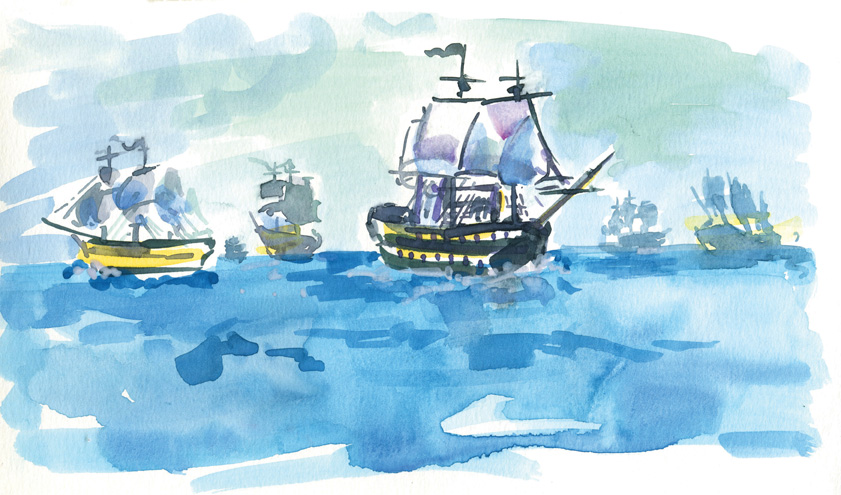
They materialized out of the Gulf’s viridian immensity on Feb. 7, 1815, and anchored at the very mouth of Mobile Bay. Astonished Americans at Fort Bowyer (site of Fort Morgan today) couldn’t believe their eyes — over 25 British ships, with more continually joining. The vessels included five hulking ships of the line: HMS Asia, Royal Oak, Norse and Bedford, each boasting two decks and 74 guns, and, most terrifying of all, the Tonnant, Admiral Sir Alexander Cochrane’s massive flagship. She was by any measure an intimidating engine of war — 194 feet long, 51 feet in the beam, with three soaring masts, 80 guns (almost half of them massive 32-pounders, so called for the weight of their projectiles) and 700 seasoned jack tars. Because Tonnant and the 74s drew over 20 feet each, they were positioned south of Dauphin Island, where they rocked in the swell, yellow sides and black gun ports lifting and falling as if in Britannic mockery of Yankee impudence.
Even closer inshore and ranged all around Mobile Point were numerous lesser but still dangerous warships. They included frigates like the Armide (40 guns) and Seahorse (38 guns), brigs like the Thistle (14 guns) and Manly (12 guns), schooners, sloops, three bomb ketches (armed with large mortars), nearly a dozen transports carrying several thousand troops and a hospital ship. No sooner had all these vessels come to rest than a bewildering variety of small craft — launches, gigs, pinnaces, jolly boats, long boats — began busily skittering among them, maintaining what one American called “an incessant communication.” More ominously, flat-bottomed barges started landing soldiers on Dauphin Island and the peninsula east of Fort Bowyer.
Unbeknownst to anyone at Mobile Bay that February, the War of 1812 had officially ended the previous December. But that was between diplomats meeting at Ghent. Until the news reached America, the fighting would continue. The British were still smarting from their January defeat at New Orleans, and Cochrane was determined to try and salvage the situation. Capt. George Gleig, an army officer on board one of the transports, expressed the admiral’s intentions succinctly: “The attack of Mobile was professedly our object.” Indeed, Cochrane planned to reduce Bowyer, take the city and then march overland toward New Orleans, cutting it off from the North and starving it. Gen. Andrew Jackson realized this, but believed his dirty shirt army would prevail no matter what the British did. Nonetheless, he warned his Mobile officers to be ready. “Cochrane is sore,” he informed them, “and Gen. Lambert [John Lambert, senior British army commander] crazy; they may in this situation attempt some act of madness.”
If Bowyer fell, and it was bound to being only a sand redoubt crowded with 376 soldiers plus three dozen women and children, Mobile was in no wise ready for a full-scale assault by the most powerful military on the planet. Sitting in his modest town lodgings, Col. John Smith reviewed the meager preparations and feared for the result. As the sun set and inky darkness crept over him, he took up a steel-nib pen in one hand and a flickering candle in the other. Scratching away at his foolscap, he described bustle and consternation in a letter to a friend. “Our little town is in arms,” he declared, “and 1,200 militia and Indians are under orders to embark with the first fair wind, to assist in the defense of the point.” Outside he could hear the rumble of cannon fire down the bay, but the strong southerly breeze that carried the sound thwarted the American troops’ departure until it was too late. The militia did manage to capture a barge with 17 British seamen near the city, who reported that Fort Bowyer had quickly capitulated and the garrison been made prisoner.
Mobile Bay was now an uncontested British lake. But before Cochrane could send his smaller vessels north to capture the city, word of the peace arrived via a brig out of Jamaica. “The news reached us on the 14th,” Gleig wrote, “and I shall not deny that it was received with general satisfaction.” If anything, that was an understatement. On board the Royal Oak, Adm. Pulteney Malcolm remarked, “I am delighted. I have hated this war from the beginning.” On shore, British soldiers lined the beaches and heartily cheered.
Still, there was no immediate departure. Cochrane wanted to await formal confirmation and in the meantime needed to reprovision before the long voyage home. There were also negotiations to be conducted with the Americans regarding the wounded, prisoner exchanges and the fate of black slaves who had fled to the safety of British arms during the campaign. Peace declared, upcountry planters were clamoring for their property, and the American government insisted they get it back. There were painful scenes when some planters traveled down to the fleet and attempted to cajole their former slaves to return while skeptical British tars watched. Some blacks believed their owners’ stories of English treachery and barbarity and did go back into bondage, but others remained on board the ships as free men.
In all, the Royal Navy spent almost two months at Mobile Bay while the army camped ashore. The soldiers passed time staging theatrical productions under sails stretched between trees or battling one another with pinecones. Inside the bay, shifting tides and winds presented them with different perspectives of their fleet each morning — a forest of masts and spars continually rearranged by nature.
At last, by late March everything was ready. Gen. Lambert dashed off a quick note to Gen. Jackson, wishing him “health and happiness” and regretting that he could not do so personally. Then, signal flags fluttering, boatswains’ whistles piping and gun salutes booming, the fleet hoisted anchor, loosed sail and left Mobile Bay for good.
John S. Sledge is the author of ‘The Gulf of Mexico: A Maritime History,’ due Fall 2019 from the University of South Carolina Press.





